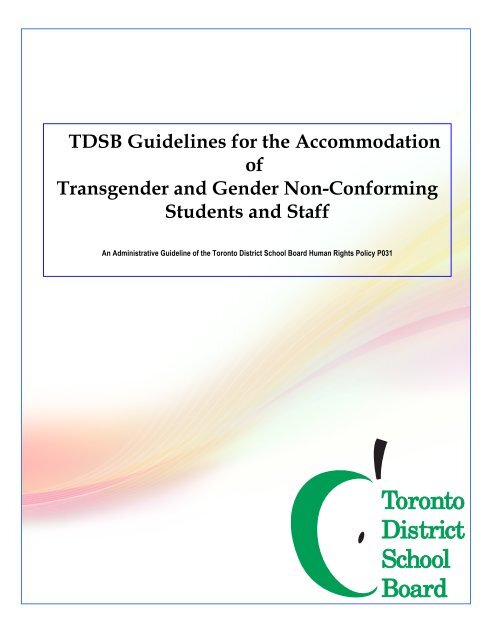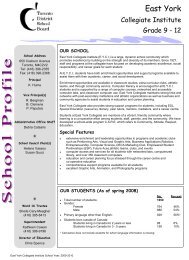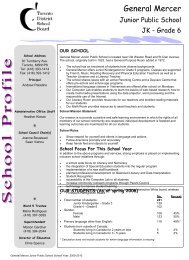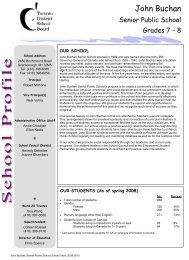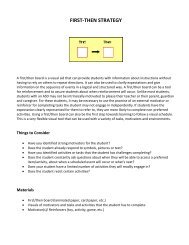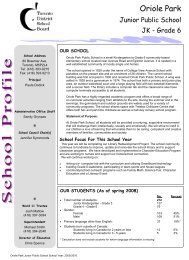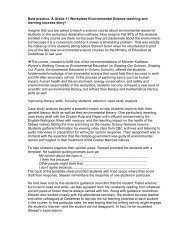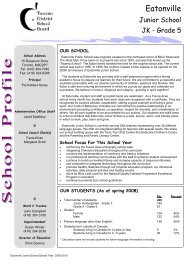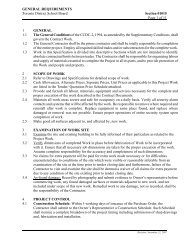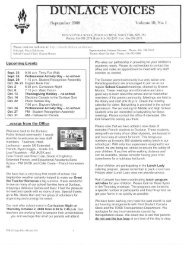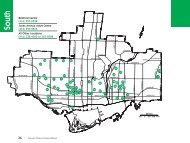TDSB Guidelines for the Accommodation of Transgender and ...
TDSB Guidelines for the Accommodation of Transgender and ...
TDSB Guidelines for the Accommodation of Transgender and ...
You also want an ePaper? Increase the reach of your titles
YUMPU automatically turns print PDFs into web optimized ePapers that Google loves.
<strong>TDSB</strong> <strong>Guidelines</strong> <strong>for</strong> <strong>the</strong> <strong>Accommodation</strong><br />
<strong>of</strong><br />
<strong>Transgender</strong> <strong>and</strong> Gender Non-Con<strong>for</strong>ming<br />
Students <strong>and</strong> Staff<br />
[Author Name]<br />
An Administrative Guideline <strong>of</strong> <strong>the</strong> Toronto District School Board Human Rights Policy P031
<strong>TDSB</strong> <strong>Guidelines</strong> <strong>for</strong> <strong>the</strong> <strong>Accommodation</strong> <strong>of</strong> <strong>Transgender</strong> <strong>and</strong> Gender Non-Con<strong>for</strong>ming Students <strong>and</strong> Staff<br />
CONTENTS<br />
1. Introduction<br />
2. Purposes <strong>and</strong> Application <strong>of</strong> <strong>the</strong> <strong>Guidelines</strong><br />
3. Definitions<br />
4. <strong>Guidelines</strong> <strong>for</strong> Students<br />
5. <strong>Guidelines</strong> <strong>for</strong> Employees<br />
6. APPENDIX A: Human Rights in Ontario – Gender Identity…Excerpt<br />
from The Ontario Human Rights Commission’s Policy on<br />
Discrimination <strong>and</strong> Harassment Because <strong>of</strong> Gender Identity<br />
APPENDIX B: Job-Related Planning <strong>for</strong> a Gender Transition<br />
APPENDIX C: Ways a school can be made a safer <strong>and</strong> genderaffirming<br />
place <strong>for</strong> transgender <strong>and</strong> gender non-con<strong>for</strong>ming youth<br />
APPENDIX D: ANNOTATED RESOURCE LISTS<br />
• <strong>TDSB</strong> Resources<br />
• Live Support <strong>for</strong> Trans Youth <strong>and</strong> <strong>the</strong>ir Families in Toronto<br />
• On-line Resources <strong>for</strong> Trans Youth <strong>and</strong> <strong>the</strong>ir Families<br />
• Films <strong>and</strong> Documentaries about Trans Youth or Young Adults<br />
<strong>and</strong> <strong>the</strong>ir Families<br />
• Supportive External Organizations <strong>for</strong> Trans Youth in Toronto<br />
• Reading Material <strong>for</strong> Trans Youth<br />
• Trans-positive Medical Care in Toronto<br />
Acknowledgements<br />
Grant Bowers, Legal Counsel <strong>TDSB</strong><br />
Patricia Hayes, Manager <strong>TDSB</strong> Human Rights Office<br />
Ken Jeffers, Coordinator <strong>TDSB</strong> Gender-Based Violence Prevention Office<br />
Javier Davila, Student Equity Program Advisor <strong>TDSB</strong> Gender-Based Violence Prevention<br />
Published 2011<br />
2
<strong>TDSB</strong> <strong>Guidelines</strong> <strong>for</strong> <strong>the</strong> <strong>Accommodation</strong> <strong>of</strong> <strong>Transgender</strong> <strong>and</strong> Gender Non-Con<strong>for</strong>ming Students <strong>and</strong> Staff<br />
1. INTRODUCTION<br />
All school boards exist within a broader context <strong>of</strong> law <strong>and</strong> public policy<br />
that protects <strong>and</strong> defends human rights.<br />
The Ontario Human Rights Code (<strong>the</strong> Code) provides <strong>for</strong> equal<br />
rights <strong>and</strong> opportunities, <strong>and</strong> freedom from discrimination. The<br />
Code recognizes <strong>the</strong> dignity <strong>and</strong> worth <strong>of</strong> every person in Ontario,<br />
in employment, housing, facilities <strong>and</strong> services, contracts, <strong>and</strong><br />
membership in unions, trade or pr<strong>of</strong>essional associations.<br />
People who are discriminated against or harassed because <strong>of</strong><br />
gender identity are legally protected under <strong>the</strong> ground <strong>of</strong> sex. This<br />
includes transsexual, transgender <strong>and</strong> intersex persons, crossdressers,<br />
<strong>and</strong> o<strong>the</strong>r people whose gender identity or expression is,<br />
or is seen to be, different from <strong>the</strong>ir birth-identified sex.<br />
(www.ohrc.on.ca/en/issues/gender_identity)<br />
At <strong>the</strong> Toronto District School Board, a number <strong>of</strong> policy statements<br />
have been developed that both rein<strong>for</strong>ce federal <strong>and</strong> provincial<br />
legislation, <strong>and</strong> help ensure that <strong>the</strong> freedoms <strong>the</strong>y name are protected<br />
within <strong>the</strong> school system. The <strong>TDSB</strong> –through its Equity Foundation<br />
Statement, Commitments to Equity Policy Implementation documents<br />
(CEPI), <strong>the</strong> Human Rights Policy <strong>and</strong> Procedures, Gender-Based Violence<br />
Policy, <strong>and</strong> Safe <strong>and</strong> Caring Schools Policy—makes clear both its<br />
commitment to upholding <strong>the</strong> dignity <strong>and</strong> worth <strong>of</strong> all persons, <strong>and</strong> <strong>the</strong><br />
high value it places on protecting all members <strong>of</strong> its community from<br />
discrimination <strong>and</strong> harassment.<br />
Related Policy Documents:<br />
Policy P029 - Employment Equity<br />
Policy P031 - Human Rights<br />
Policy P034 - Workplace Harassment<br />
Policy P037 - Equity Foundation<br />
Policy P051 - Safe Schools<br />
Policy P065 - Bullying Prevention <strong>and</strong> Intervention<br />
Policy P071 - Gender-based Violence<br />
Policy P072 - Workplace Violence Prevention<br />
3
<strong>TDSB</strong> <strong>Guidelines</strong> <strong>for</strong> <strong>the</strong> <strong>Accommodation</strong> <strong>of</strong> <strong>Transgender</strong> <strong>and</strong> Gender Non-Con<strong>for</strong>ming Students <strong>and</strong> Staff<br />
2. PURPOSES AND APPLICATION OF THE GUIDELINES<br />
These guidelines set out <strong>the</strong> <strong>TDSB</strong>’s best practices related to<br />
accommodation based on gender identity <strong>and</strong> gender expression. They<br />
have been designed to raise awareness <strong>and</strong> help protect against<br />
discrimination <strong>and</strong> harassment. It is intended that this document will<br />
support members <strong>of</strong> <strong>the</strong> wider <strong>TDSB</strong> community fulfill our shared<br />
obligation to promote <strong>the</strong> dignity <strong>and</strong> equality <strong>of</strong> those whose gender<br />
identity <strong>and</strong> or gender expression does not con<strong>for</strong>m to traditional social<br />
norms.<br />
It is expected that <strong>the</strong> guidelines will be adhered to in general; however,<br />
it is also recognized that specific accommodations sought are to be<br />
fulfilled on case-by-case basis <strong>and</strong> individualized to best meet <strong>the</strong> needs<br />
<strong>of</strong> a student or employee who is making an accommodation request.<br />
<strong>Accommodation</strong> Based on Request. The Toronto District School<br />
Board will take reasonable steps to provide accommodation to staff or<br />
students who state that <strong>the</strong> Board’s operations or requirements interfere<br />
with <strong>the</strong>ir right to free gender expression <strong>and</strong> or gender identity. The<br />
Board will balance its decision to accommodate on several factors, such<br />
as undue hardship, including: <strong>the</strong> cost <strong>of</strong> <strong>the</strong> accommodation to <strong>the</strong><br />
Board; health <strong>and</strong> safety risks to <strong>the</strong> person requesting accommodation<br />
<strong>and</strong> to o<strong>the</strong>rs; <strong>and</strong> <strong>the</strong> effect <strong>of</strong> accommodation on <strong>the</strong> Board’s ability<br />
to fulfill its duties under Board policies <strong>and</strong> <strong>the</strong> Education Act.<br />
Unresolved Requests. Despite <strong>the</strong> Board’s commitment to<br />
accommodate, an individual may feel that discrimination has occurred.<br />
The Board will, through its Human Rights Policy <strong>and</strong> Procedures, take<br />
reasonable steps to address <strong>the</strong> unresolved issues raised by <strong>the</strong> affected<br />
person.<br />
3. DEFINITIONS<br />
The definitions provided below are not meant to label an individual but<br />
are intended as sometimes helpful functional descriptors. These words,<br />
like all words, are social constructs developed over time. (New language<br />
is constantly <strong>for</strong>med to unite community members as well as divide<br />
groups by experience, politics, <strong>and</strong> o<strong>the</strong>r group memberships.)<br />
These terms <strong>and</strong> definitions are NOT st<strong>and</strong>ardized <strong>and</strong> may be used<br />
differently by different people, <strong>and</strong> in different regions. Labels <strong>and</strong><br />
identities should only be self-selected by individuals, not assumed by<br />
o<strong>the</strong>rs. Biology does not imply identity. Nor do behaviour <strong>and</strong><br />
expression alone constitute identity.<br />
4
<strong>TDSB</strong> <strong>Guidelines</strong> <strong>for</strong> <strong>the</strong> <strong>Accommodation</strong> <strong>of</strong> <strong>Transgender</strong> <strong>and</strong> Gender Non-Con<strong>for</strong>ming Students <strong>and</strong> Staff<br />
Biological Sex: generally refers to <strong>the</strong> sex assigned at birth based on<br />
external external genitalia but also includes internal reproductive<br />
structures, chromosomes, hormone levels, <strong>and</strong> secondary sex<br />
characteristics such as breasts, facial <strong>and</strong> body hair, <strong>and</strong> fat distribution.<br />
Gender Identity: is linked to an individual’s intrinsic sense <strong>of</strong> self <strong>and</strong><br />
<strong>the</strong>ir sense <strong>of</strong> being female, male, a combination <strong>of</strong> both, or nei<strong>the</strong>r<br />
regardless <strong>of</strong> <strong>the</strong>ir biological sex.<br />
Gender Expression: refers to <strong>the</strong> way an individual expresses <strong>the</strong>ir<br />
gender identity (e.g. in <strong>the</strong> way <strong>the</strong>y dress, <strong>the</strong> length <strong>and</strong> style <strong>of</strong> <strong>the</strong>ir<br />
hair, <strong>the</strong> way <strong>the</strong>y act or speak, <strong>the</strong> volume <strong>of</strong> <strong>the</strong>ir voice, <strong>and</strong> in <strong>the</strong>ir<br />
choice <strong>of</strong> whe<strong>the</strong>r or not to wear make-up.)<br />
Gender Non-Con<strong>for</strong>ming: refers to individuals who do not follow o<strong>the</strong>r<br />
people’s ideas or stereotypes about how <strong>the</strong>y should look or act based<br />
on <strong>the</strong> female or male sex <strong>the</strong>y were assigned at birth (also called<br />
Gender Variance <strong>and</strong>/or Gender Independence). For example, this<br />
includes “feminine boys,” “masculine girls,” <strong>and</strong> individuals who are<br />
<strong>and</strong>rogynous. Ano<strong>the</strong>r example might be a male who comes to school in<br />
clothing that some might perceive as “girls’ clothing,” or <strong>the</strong> girl who<br />
plays games on <strong>the</strong> playground that might be perceived as “boys’<br />
games.”<br />
Intersex: a person who has male <strong>and</strong> female genetic <strong>and</strong>/or physical<br />
sex characteristics.<br />
<strong>Transgender</strong>: refers to individuals whose gender identity is different<br />
from <strong>the</strong>ir biological sex at birth, <strong>and</strong>/or whose gender expression is<br />
different from <strong>the</strong> way males or females are stereotypically expected to<br />
look or behave.<br />
Transition: <strong>the</strong> process (which <strong>for</strong> some people may also be referred to<br />
as <strong>the</strong> “gender reassignment process”) whereby people change <strong>the</strong>ir<br />
appearance <strong>and</strong> bodies to match <strong>the</strong>ir internal (gender) identity, while<br />
living <strong>the</strong>ir lives full-time in <strong>the</strong>ir preferred gender role.<br />
Transsexual: a term <strong>for</strong> a person who undergoes a medical gender<br />
reassignment process to change <strong>the</strong>ir birth-assigned sex.<br />
Two-spirit: an English term coined to reflect specific cultural words<br />
used by First Nation <strong>and</strong> o<strong>the</strong>r indigenous peoples <strong>for</strong> those in <strong>the</strong>ir<br />
cultures who are gay or lesbian, are transgendered or transsexual, or<br />
have multiple gender identities.<br />
5
<strong>TDSB</strong> <strong>Guidelines</strong> <strong>for</strong> <strong>the</strong> <strong>Accommodation</strong> <strong>of</strong> <strong>Transgender</strong> <strong>and</strong> Gender Non-Con<strong>for</strong>ming Students <strong>and</strong> Staff<br />
4. GUIDELINES FOR STUDENTS<br />
If you are a transgender or gender non-con<strong>for</strong>ming individual, you have<br />
<strong>the</strong> right to be who you are openly. This includes expressing your<br />
gender identity without fear <strong>of</strong> unwanted consequences. You have <strong>the</strong><br />
right to be treated with dignity <strong>and</strong> respect.<br />
Individual Procedures. Board <strong>and</strong> school staff must consider each<br />
student’s needs <strong>and</strong> concerns separately. Each transgender <strong>and</strong> gender<br />
non-con<strong>for</strong>ming student is unique with different needs. An<br />
accommodation that works <strong>for</strong> one student cannot simply be assumed to<br />
work <strong>for</strong> ano<strong>the</strong>r.<br />
Privacy. All students have a right to privacy; schools must keep a<br />
student’s transgender/gender non-con<strong>for</strong>ming status confidential.<br />
There<strong>for</strong>e, school staff should not disclose a student’s<br />
transgender/gender non-con<strong>for</strong>ming status to o<strong>the</strong>rs unless <strong>the</strong>re is a<br />
specific “need to know” (e.g., to fulfill a specific accommodation<br />
request).<br />
Some transgender <strong>and</strong> gender non-con<strong>for</strong>ming students are not openly<br />
so at home because <strong>of</strong> safety <strong>and</strong> or o<strong>the</strong>r reasons. A school should<br />
never disclose a student’s gender non-con<strong>for</strong>mity or transgender status<br />
to <strong>the</strong> student’s parent(s)/guardian(s)/caregiver(s) without <strong>the</strong><br />
student’s explicit prior consent.<br />
When school staff contact <strong>the</strong> home <strong>of</strong> a transgender or gender noncon<strong>for</strong>ming<br />
student, <strong>the</strong> student should be consulted first to determine<br />
an appropriate way to reference <strong>the</strong> student’s gender identity. It is<br />
strongly suggested that staff privately ask transgender or gender noncon<strong>for</strong>ming<br />
students at <strong>the</strong> beginning <strong>of</strong> <strong>the</strong> school year how <strong>the</strong>y want<br />
to be addressed in correspondence to <strong>the</strong> home or at meetings with <strong>the</strong><br />
student’s parent(s)/guardian(s)/caregiver(s).<br />
Official Records. The school will change a student’s <strong>of</strong>ficial records to<br />
reflect a change in legal name or gender upon receipt <strong>of</strong> documentation<br />
that such legal name or gender has been changed pursuant to a court<br />
order.<br />
6
<strong>TDSB</strong> <strong>Guidelines</strong> <strong>for</strong> <strong>the</strong> <strong>Accommodation</strong> <strong>of</strong> <strong>Transgender</strong> <strong>and</strong> Gender Non-Con<strong>for</strong>ming Students <strong>and</strong> Staff<br />
Names/Pronouns. <strong>Transgender</strong> <strong>and</strong> gender non-con<strong>for</strong>ming students<br />
have <strong>the</strong> right to be addressed by a name <strong>and</strong> pronoun corresponding to<br />
<strong>the</strong>ir gender identity. This is true regardless <strong>of</strong> whe<strong>the</strong>r <strong>the</strong> student has<br />
obtained a court ordered name or gender change. For example, under<br />
<strong>the</strong> Ontario Trillium school identification system, a student’s “preferred<br />
or chosen name” <strong>and</strong> a change <strong>of</strong> gender can be used on class lists,<br />
timetables, etc.<br />
Intentionally addressing a student by <strong>the</strong> incorrect name or pronoun is a<br />
<strong>for</strong>m <strong>of</strong> discrimination. This directive does not prohibit inadvertent slips<br />
or honest mistakes, but it does apply to <strong>the</strong> intentional <strong>and</strong> persistent<br />
refusal to acknowledge or use a student’s gender identity.<br />
Students who wish to use pronouns o<strong>the</strong>r than <strong>the</strong> masculine or <strong>the</strong><br />
feminine (such as ‘zhe’ <strong>and</strong> ‘hir’) need to be accommodated equally.<br />
NOTE: Students <strong>and</strong> employees who wish to use gender-neutral <strong>and</strong><br />
gender inclusive language in <strong>TDSB</strong> schools <strong>and</strong> workplaces should be<br />
supported to do so. For example, some people do not feel included in<br />
<strong>the</strong> generic binary <strong>of</strong> “he or she”. Students <strong>and</strong> staff may wish to write<br />
in such a way as to avoid it. An increasingly common <strong>and</strong> accepted<br />
strategy is to use “<strong>the</strong>y” as a gender-neutral singular pronoun, as this<br />
document <strong>of</strong>ten does. (For a useful legally-oriented source on this,<br />
please see www.editorscanberra.org/a-singular-use-<strong>of</strong>-<strong>the</strong>y/ )<br />
St<strong>and</strong>ardized Forms <strong>and</strong> Documentation<br />
Board staff will send an annual advisory to all schools to ensure<br />
st<strong>and</strong>ardized <strong>for</strong>ms are appropriately amended to reflect <strong>the</strong>se<br />
guidelines. The advisory will rein<strong>for</strong>ce <strong>the</strong> expectation that schools<br />
use gender-neutral language <strong>and</strong> <strong>of</strong>fer gender-inclusive choices. (E.g.,<br />
“Select <strong>the</strong> gender identity that best fits you: Female, Male, Trans.”)<br />
Washroom Access. All students have a right to safe restroom facilities<br />
<strong>and</strong> <strong>the</strong> right to use a washroom that corresponds to <strong>the</strong> student’s<br />
gender identity, regardless <strong>of</strong> <strong>the</strong> student’s sex assigned at birth.<br />
Requiring students to ‘prove’ <strong>the</strong>ir gender (by requiring a doctor’s letter,<br />
identity documents, etc.) is not acceptable. A student’s selfidentification<br />
is <strong>the</strong> sole measure <strong>of</strong> <strong>the</strong> student’s gender.<br />
7
<strong>TDSB</strong> <strong>Guidelines</strong> <strong>for</strong> <strong>the</strong> <strong>Accommodation</strong> <strong>of</strong> <strong>Transgender</strong> <strong>and</strong> Gender Non-Con<strong>for</strong>ming Students <strong>and</strong> Staff<br />
Where possible, schools will also provide an easily accessible all-gender<br />
single stall washroom <strong>for</strong> use by any student who desires increased<br />
privacy, regardless <strong>of</strong> <strong>the</strong> underlying reason. However, use <strong>of</strong> an allgender<br />
single stall washroom should always be a matter <strong>of</strong> choice <strong>for</strong> a<br />
student. No student should be compelled to use one due to continuing<br />
harassment in a gender-appropriate facility. If possible, more than one<br />
all-gender washroom is encouraged.<br />
Dress Codes. Schools’ dress codes must be flexible <strong>and</strong> gender-neutral.<br />
Students should not have to choose between ‘male’ <strong>and</strong> ‘female’<br />
clothing. Some students are most com<strong>for</strong>table in <strong>and</strong> most <strong>the</strong>mselves<br />
in clothing that is not clearly male-identified or female-identified, but<br />
ra<strong>the</strong>r a combination <strong>of</strong> <strong>the</strong> two.<br />
Sports Activities, Gym Classes, <strong>and</strong> Change Rooms. School staff<br />
must ensure students can exercise <strong>the</strong>ir right to participate in gendersegregated<br />
sports <strong>and</strong> physical education (P.E.) class activities in<br />
accordance with each student’s gender identity.<br />
Students have <strong>the</strong> right to a safe change-room that corresponds to <strong>the</strong>ir<br />
gender identity. <strong>Transgender</strong> or gender non-con<strong>for</strong>ming students have<br />
<strong>the</strong> right to an accommodation that best meets <strong>the</strong> individual student’s<br />
particular needs. Such accommodations can include: (A) use <strong>of</strong> a private<br />
area within <strong>the</strong> public area (a bathroom stall with a door; an area<br />
separated by a curtain; a P.E. instructor’s <strong>of</strong>fice in <strong>the</strong> change-room);<br />
(B) a separate changing schedule in <strong>the</strong> private area (ei<strong>the</strong>r utilizing <strong>the</strong><br />
change room be<strong>for</strong>e or after <strong>the</strong> o<strong>the</strong>r students); (C) use <strong>of</strong> a nearby<br />
private area (a nearby washroom; a nurse’s <strong>of</strong>fice); (D) access to <strong>the</strong><br />
change room corresponding to <strong>the</strong> student’s assigned sex at birth, or (E)<br />
satisfaction <strong>of</strong> <strong>the</strong> P.E. requirement by independent study outside <strong>of</strong><br />
gym class.<br />
It is not an acceptable accommodation to deny a student <strong>the</strong><br />
opportunity <strong>for</strong> physical education ei<strong>the</strong>r by not allowing <strong>the</strong> student to<br />
have P.E., or by <strong>for</strong>cing <strong>the</strong> student to choose independent study.<br />
Requiring a transgender or gender non-con<strong>for</strong>ming student to use <strong>the</strong><br />
change room corresponding to <strong>the</strong> student’s sex assigned at birth is<br />
likewise prohibited.<br />
Curriculum Integration <strong>and</strong> Access to Accurate In<strong>for</strong>mation.<br />
School board <strong>and</strong> school staff shall challenge gender stereotypes <strong>and</strong><br />
8
<strong>TDSB</strong> <strong>Guidelines</strong> <strong>for</strong> <strong>the</strong> <strong>Accommodation</strong> <strong>of</strong> <strong>Transgender</strong> <strong>and</strong> Gender Non-Con<strong>for</strong>ming Students <strong>and</strong> Staff<br />
integrate trans-positive content into <strong>the</strong> teaching <strong>of</strong> all subject areas.<br />
Too <strong>of</strong>ten, <strong>the</strong> existence <strong>of</strong> transgender people is erased or only included<br />
in a highly stigmatized way in classrooms, as well as in <strong>the</strong> media <strong>and</strong><br />
popular culture. The lack <strong>of</strong> any positive acknowledgment <strong>of</strong> transgender<br />
issues or transgender history makes it difficult <strong>for</strong> transgender, gender<br />
noncon<strong>for</strong>ming, or questioning young people to feel that <strong>the</strong>y have a<br />
place in <strong>the</strong> world. Unless it is corrected, <strong>the</strong> omission <strong>of</strong> transgender<br />
<strong>and</strong> gender non-con<strong>for</strong>ming people from <strong>the</strong> curriculum creates a<br />
misconception among many students that transgender people do not<br />
exist or are an object <strong>of</strong> scorn.<br />
School board <strong>and</strong> school–based curriculum leaders must integrate transawareness<br />
<strong>and</strong> trans-positive advocacy training into staff pr<strong>of</strong>essional<br />
development curricula. Librarians must acquire trans-positive fiction <strong>and</strong><br />
non-fiction books <strong>for</strong> school libraries <strong>and</strong> encourage <strong>the</strong> circulation <strong>of</strong><br />
books that teach about gender non-con<strong>for</strong>ming people.<br />
Pr<strong>of</strong>essional Learning, Advocacy Support, <strong>and</strong> Role Models.<br />
School board leaders must ensure staff are educated in anti-transphobia<br />
education, in challenging gender stereotypes, <strong>and</strong> in using gender<br />
neutral <strong>and</strong> inclusive language. School <strong>and</strong> board-based leaders should<br />
designate a staff person within <strong>the</strong> school, or school district, who can act<br />
in an extended advocacy role <strong>for</strong> trans students (e.g., <strong>the</strong> Positive Space<br />
representative).<br />
Often, transgender <strong>and</strong> gender non-con<strong>for</strong>ming students feel like <strong>the</strong>y<br />
are alone in <strong>the</strong> world. There are very few transgender role models in<br />
schools. School leaders should make an ef<strong>for</strong>t to hire <strong>and</strong> retain<br />
transgender <strong>and</strong> gender non-con<strong>for</strong>ming staff.<br />
Student Engagement <strong>and</strong> Student Leadership. Schools should<br />
support <strong>the</strong> development <strong>of</strong> a trans-inclusive GSA (Gay-Straight<br />
Alliance).<br />
School board <strong>and</strong> school staff should encourage <strong>and</strong> support<br />
scholarships <strong>and</strong> awards that recognize <strong>the</strong> unique strength <strong>and</strong><br />
resilience that transgender <strong>and</strong> gender non-con<strong>for</strong>ming youth possess.<br />
They should support actions, activities <strong>and</strong> campaigns that are transpositive<br />
<strong>and</strong> create awareness about transphobia, gender stereotypes,<br />
<strong>and</strong> gender-based violence.<br />
9
<strong>TDSB</strong> <strong>Guidelines</strong> <strong>for</strong> <strong>the</strong> <strong>Accommodation</strong> <strong>of</strong> <strong>Transgender</strong> <strong>and</strong> Gender Non-Con<strong>for</strong>ming Students <strong>and</strong> Staff<br />
Gender Segregation in O<strong>the</strong>r Areas. As a general rule, in any o<strong>the</strong>r<br />
circumstances where students are separated by gender in school<br />
activities (e.g., class discussions, field trips), students shall be permitted<br />
to participate in accordance with <strong>the</strong>ir gender identity.<br />
Activities that may involve <strong>the</strong> need <strong>for</strong> housing accommodations in<br />
order to address student privacy concerns will be addressed on a caseby-case<br />
basis. In such circumstances, staff shall make every reasonable<br />
ef<strong>for</strong>t to provide an accommodation that is acceptable to <strong>the</strong> student. If<br />
transgender or gender non-con<strong>for</strong>ming students object to st<strong>and</strong>ard<br />
gender-separated housing accommodations or shared accommodations<br />
<strong>for</strong> reasons <strong>of</strong> privacy or safety, private accommodations should be<br />
made available at no additional cost to <strong>the</strong> student.<br />
10
<strong>TDSB</strong> <strong>Guidelines</strong> <strong>for</strong> <strong>the</strong> <strong>Accommodation</strong> <strong>of</strong> <strong>Transgender</strong> <strong>and</strong> Gender Non-Con<strong>for</strong>ming Students <strong>and</strong> Staff<br />
5. GUIDELINES FOR EMPLOYEES<br />
If you are a transgender or gender non-con<strong>for</strong>ming individual, you have<br />
<strong>the</strong> right to be who you are openly. This includes expressing your<br />
gender identity without fear <strong>of</strong> unwanted consequences. You have <strong>the</strong><br />
right to be treated with dignity <strong>and</strong> respect.<br />
Gender Expression. All employees have <strong>the</strong> right to dress consistently<br />
with <strong>the</strong>ir gender expression. For transitioning employees, <strong>the</strong> decision<br />
as to when <strong>and</strong> how to begin <strong>the</strong> real-life experience remains <strong>the</strong><br />
individual’s choice.<br />
Washroom Access. Employees have <strong>the</strong> right to use a washroom that<br />
corresponds to <strong>the</strong>ir gender identity, regardless <strong>of</strong> <strong>the</strong>ir sex assigned at<br />
birth. Requiring employees to ‘prove’ <strong>the</strong>ir gender (by requiring a<br />
doctor’s letter, identity documents, etc.) is not acceptable. The<br />
employee’s self-identification is <strong>the</strong> sole measure <strong>of</strong> <strong>the</strong>ir gender.<br />
Where possible, schools will also provide an easily accessible all-gender<br />
single stall washroom <strong>for</strong> use by any employee who desires increased<br />
privacy, regardless <strong>of</strong> <strong>the</strong> underlying reason. However, use <strong>of</strong> an allgender<br />
single stall washroom should always be a matter <strong>of</strong> choice <strong>for</strong> an<br />
employee. No individual should be compelled to use one due to<br />
continuing harassment in a gender appropriate facility. If possible, <strong>the</strong><br />
provision <strong>of</strong> more than one all-gender washroom is encouraged.<br />
Notification <strong>of</strong> Transition. An individual employee beginning <strong>the</strong><br />
transition process should contact <strong>the</strong>ir immediate supervisor <strong>and</strong> <strong>the</strong><br />
Human Rights Office, <strong>and</strong> be prepared to speak about <strong>the</strong>ir intentions,<br />
needs, <strong>and</strong> concerns. Individual employees should make <strong>the</strong>se contacts<br />
well be<strong>for</strong>e a planned transition date.<br />
If <strong>the</strong> initial contact is made with Human Rights Office, it is important at<br />
some point that <strong>the</strong> individual’s immediate supervisor join <strong>the</strong>ir support<br />
team. Transitioning individuals should be prepared to help in<strong>for</strong>m <strong>and</strong><br />
educate <strong>the</strong>ir manager <strong>and</strong> o<strong>the</strong>rs in order to clarify <strong>the</strong>ir needs <strong>for</strong><br />
accommodation.<br />
Internal <strong>and</strong> external resources to assist transitioning individuals in this<br />
educational ef<strong>for</strong>t are listed at <strong>the</strong> end <strong>of</strong> this document.<br />
11
<strong>TDSB</strong> <strong>Guidelines</strong> <strong>for</strong> <strong>the</strong> <strong>Accommodation</strong> <strong>of</strong> <strong>Transgender</strong> <strong>and</strong> Gender Non-Con<strong>for</strong>ming Students <strong>and</strong> Staff<br />
Statement <strong>of</strong> Confidentiality. The transgender status <strong>of</strong> an employee<br />
is considered confidential <strong>and</strong> should only be disclosed on a need-toknow<br />
basis, <strong>and</strong> only with <strong>the</strong> consent <strong>of</strong> <strong>the</strong> employee. However,<br />
transitioning employees are encouraged to participate in <strong>the</strong> necessary<br />
education <strong>of</strong> <strong>the</strong>ir coworkers at whatever level <strong>the</strong>y are com<strong>for</strong>table.<br />
In addition, current <strong>and</strong> prospective transgender <strong>and</strong> gender noncon<strong>for</strong>ming<br />
employees who encounter problems concerning identification<br />
documentation, such as payroll <strong>and</strong> insurance <strong>for</strong>ms, are encouraged to<br />
raise those concerns with <strong>the</strong> Human Rights Office directly.<br />
Special Advice <strong>for</strong> Management & Employee Services. If an<br />
employee in<strong>for</strong>ms a manager <strong>of</strong> <strong>the</strong>ir intention to transition, or if an<br />
employee is currently in <strong>the</strong> transitioning process, <strong>the</strong> manager’s<br />
support is critical.<br />
If you are <strong>the</strong> transitioning employee’s manager, recognize that your<br />
actions will decisively impact <strong>the</strong> outcome <strong>of</strong> <strong>the</strong> transition.<br />
It may be frightening to a employee to be vulnerable to a person upon<br />
whom <strong>the</strong>ir job depends. Allow <strong>the</strong> transgender or gender noncon<strong>for</strong>ming<br />
employee to educate you, or seek in<strong>for</strong>mation from <strong>the</strong><br />
resources listed at <strong>the</strong> end <strong>of</strong> this document. Show that you are openminded<br />
<strong>and</strong> discuss with <strong>the</strong> employee <strong>the</strong>ir needs <strong>and</strong> concerns.<br />
The Human Rights Office will provide advice <strong>and</strong> assistance <strong>for</strong><br />
supervisors working with a transitioning employee.<br />
Managers <strong>and</strong> supervisors should be careful <strong>of</strong> voicing personal opinions<br />
regarding an employee’s appearance. If an employee dresses or<br />
behaves in a manner inappropriate <strong>for</strong> <strong>the</strong> workplace, this issue should<br />
be dealt with in <strong>the</strong> same manner it would with any o<strong>the</strong>r employee.<br />
Contact <strong>the</strong> Human Rights Office if you have any questions or concerns.<br />
Fur<strong>the</strong>r Advice <strong>for</strong> Managers Regarding <strong>the</strong> Initial Conversation<br />
with a Transitioning Employee. Begin by reassuring <strong>the</strong> employee<br />
that you will be as supportive as possible. Assure <strong>the</strong> employee that<br />
<strong>the</strong>y are covered by <strong>the</strong> <strong>TDSB</strong> Human Rights Policy <strong>and</strong> <strong>the</strong> Ontario<br />
Human Rights Code, both <strong>of</strong> which recognize <strong>the</strong> individual’s inherent<br />
dignity <strong>and</strong> worth, provide <strong>for</strong> equal rights <strong>and</strong> opportunities without<br />
12
<strong>TDSB</strong> <strong>Guidelines</strong> <strong>for</strong> <strong>the</strong> <strong>Accommodation</strong> <strong>of</strong> <strong>Transgender</strong> <strong>and</strong> Gender Non-Con<strong>for</strong>ming Students <strong>and</strong> Staff<br />
discrimination, <strong>and</strong> aim to create a climate <strong>of</strong> underst<strong>and</strong>ing <strong>and</strong> mutual<br />
respect.<br />
Make it clear to <strong>the</strong> employee that your conversation will be held in<br />
confidence <strong>and</strong> in<strong>for</strong>m <strong>the</strong> employee that you want to discuss how you<br />
<strong>and</strong> <strong>the</strong> Human Rights Office can assist <strong>the</strong>m during <strong>the</strong>ir transition. Ask<br />
<strong>the</strong> employee <strong>for</strong> <strong>the</strong>ir suggestions on what you can do to help.<br />
Confirm who will be <strong>the</strong> organization’s main point <strong>of</strong> contact (manager<br />
or Human Rights Office) to manage <strong>the</strong> transition. Schedule a meeting<br />
with <strong>the</strong> employee to discuss <strong>and</strong> agree upon an action plan to assist<br />
<strong>the</strong> employee in <strong>the</strong>ir transition.<br />
Ask <strong>the</strong> employee if <strong>the</strong>y wish to in<strong>for</strong>m <strong>the</strong>ir manager, co-workers,<br />
(<strong>and</strong> students) <strong>the</strong>mselves, or prefer that this to be done <strong>for</strong> <strong>the</strong>m. Then<br />
determine <strong>the</strong> best timing <strong>for</strong> that process.<br />
Ask <strong>the</strong> employee if <strong>the</strong>y expect to change <strong>the</strong>ir name. If yes, ask what<br />
name <strong>and</strong> pronoun <strong>the</strong> employee will use <strong>and</strong> when <strong>the</strong> employee will<br />
want you to begin referring to <strong>the</strong>m using <strong>the</strong> new name <strong>and</strong>/or<br />
pronoun.<br />
Discuss <strong>the</strong> expected timeline <strong>and</strong> anticipated time <strong>of</strong>f required <strong>for</strong> any<br />
potential medical treatment, if known. Explain that normal sick pay <strong>and</strong><br />
leave policies will apply.<br />
<strong>Accommodation</strong>-based Requests For Transfer. An employee may<br />
feel more com<strong>for</strong>table working in a different position during <strong>and</strong> or after<br />
<strong>the</strong>ir transition. Managers should be prepared to discuss whe<strong>the</strong>r <strong>the</strong><br />
employee prefers to remain in <strong>the</strong>ir current position or be redeployed.<br />
In such instances, employees are encouraged to contact <strong>the</strong> Human<br />
Rights Office in order to facilitate discussions with Elementary,<br />
Secondary or Support Staff Employee Services Office, <strong>and</strong> if required<br />
with <strong>the</strong> appropriate bargaining unit.<br />
Addressing Concerns <strong>of</strong> Co-workers <strong>and</strong> Community. A lack <strong>of</strong><br />
knowledge about transgender issues has <strong>the</strong> potential <strong>for</strong> creating<br />
misunderst<strong>and</strong>ing <strong>and</strong> tension in <strong>the</strong> workplace. Managers should<br />
remind all employees that <strong>the</strong>y are expected to conduct <strong>the</strong>mselves in<br />
accordance with <strong>TDSB</strong> Human Rights Policies <strong>and</strong> Procedures.<br />
13
<strong>TDSB</strong> <strong>Guidelines</strong> <strong>for</strong> <strong>the</strong> <strong>Accommodation</strong> <strong>of</strong> <strong>Transgender</strong> <strong>and</strong> Gender Non-Con<strong>for</strong>ming Students <strong>and</strong> Staff<br />
In addition to <strong>the</strong> initial workgroup meeting at which <strong>the</strong> employee’s<br />
manager announces <strong>the</strong> transition (see Appendix B), managers should<br />
arrange trainings or briefing sessions <strong>for</strong> employees on transgender<br />
issues; this will help promote a positive work environment <strong>for</strong> all<br />
employees.<br />
Trainings or briefing sessions should be completed prior to <strong>the</strong><br />
employee’s transition. This provides important in<strong>for</strong>mation to coworkers,<br />
managers, <strong>and</strong> clients on what to expect when <strong>the</strong> individual<br />
begins his or her transition. Establishing some level <strong>of</strong> com<strong>for</strong>t as to<br />
what <strong>the</strong> transition is <strong>and</strong> why it is happening is important <strong>for</strong><br />
preventing future misunderst<strong>and</strong>ings or issues.<br />
Employees who raise concerns about a transgender co-worker should be<br />
referred to <strong>the</strong> Ontario Human Rights Code, <strong>the</strong> <strong>TDSB</strong> Human Rights<br />
policies <strong>and</strong> procedures, <strong>and</strong> <strong>the</strong> <strong>TDSB</strong>’s harassment policy <strong>and</strong> o<strong>the</strong>r<br />
related policies. They should be in<strong>for</strong>med that <strong>the</strong>y must work cooperatively<br />
<strong>and</strong> respectfully with <strong>the</strong>ir co-workers regardless <strong>of</strong> <strong>the</strong>ir<br />
gender identity, <strong>and</strong> that failure to do so could result in corrective<br />
action, including termination <strong>of</strong> <strong>the</strong>ir employment.<br />
Pronoun <strong>and</strong> Name Changes. Employee records <strong>and</strong> work-related<br />
documents should be retained under <strong>the</strong> individual’s legal name (as<br />
reflected on identification documents verified at <strong>the</strong> start <strong>of</strong><br />
employment) unless <strong>and</strong> until <strong>the</strong> individual makes a legal change.<br />
Where a person’s legal name does not match <strong>the</strong>ir new name, <strong>the</strong> new<br />
name should be used on all documentation, such as e-mail, phone<br />
directory, company identification card or access badge, name plate,<br />
class lists etc., except where records must match <strong>the</strong> legal name, such<br />
as insurance documents.<br />
In everyday written <strong>and</strong> oral speech, <strong>the</strong> new name <strong>and</strong> pronouns<br />
should be used when <strong>the</strong> employee indicates he or she (or possibly<br />
ano<strong>the</strong>r gender pronoun variant, see below) is ready.<br />
Intentionally addressing an employee by an incorrect name or pronoun<br />
is a <strong>for</strong>m <strong>of</strong> discrimination. This directive does not prohibit inadvertent<br />
slips or honest mistakes, but it does apply to <strong>the</strong> intentional <strong>and</strong><br />
persistent refusal to respect an individual’s gender identity.<br />
Employees who wish to use pronouns o<strong>the</strong>r than <strong>the</strong> masculine or <strong>the</strong><br />
feminine (such as ‘zhe’ <strong>and</strong> ‘hir’) need to be accommodated equally.<br />
14
<strong>TDSB</strong> <strong>Guidelines</strong> <strong>for</strong> <strong>the</strong> <strong>Accommodation</strong> <strong>of</strong> <strong>Transgender</strong> <strong>and</strong> Gender Non-Con<strong>for</strong>ming Students <strong>and</strong> Staff<br />
NOTE: Students <strong>and</strong> employees who wish to use gender-neutral <strong>and</strong><br />
gender inclusive language in <strong>TDSB</strong> schools <strong>and</strong> workplaces should be<br />
supported to do so. For example, some people do not feel included in<br />
<strong>the</strong> generic binary <strong>of</strong> “he or she”. Students <strong>and</strong> staff may wish to write<br />
in such a way as to avoid it. An increasingly common <strong>and</strong> accepted<br />
strategy is to use “<strong>the</strong>y” as a gender-neutral singular pronoun, as this<br />
document <strong>of</strong>ten does. (For a useful legally-oriented source on this,<br />
please see www.editorscanberra.org/a-singular-use-<strong>of</strong>-<strong>the</strong>y/ )<br />
Surgeries. The process <strong>of</strong> transitioning may include one or more<br />
surgeries. In addition to genital surgery, surgeries can include facial<br />
feminization or o<strong>the</strong>r feminizing procedures <strong>for</strong> those transitioning from<br />
male to female, or chest reconstruction or o<strong>the</strong>r surgeries <strong>for</strong> those<br />
transitioning from female to male. Recognize that a transitioning<br />
employee may or may not have <strong>the</strong>se surgeries <strong>for</strong> any number <strong>of</strong><br />
personal reasons <strong>and</strong>, fur<strong>the</strong>rmore, that surgery in <strong>and</strong> <strong>of</strong> itself is not<br />
<strong>the</strong> goal or purpose <strong>of</strong> a gender transition.<br />
Medical in<strong>for</strong>mation, including surgery plans communicated by an<br />
employee, must be treated confidentially.<br />
15
<strong>TDSB</strong> <strong>Guidelines</strong> <strong>for</strong> <strong>the</strong> <strong>Accommodation</strong> <strong>of</strong> <strong>Transgender</strong> <strong>and</strong> Gender Non-Con<strong>for</strong>ming Students <strong>and</strong> Staff<br />
APPENDIX A:<br />
Human Rights in Ontario – Gender Identity<br />
Excerpt from The Ontario Human Rights Commission’s Policy on<br />
Discrimination <strong>and</strong> Harassment Because <strong>of</strong> Gender Identity<br />
Ontario’s Human Rights Code<br />
The Ontario Human Rights Code (<strong>the</strong> Code) provides <strong>for</strong> equal rights<br />
<strong>and</strong> opportunities, <strong>and</strong> freedom from discrimination. The Code<br />
recognizes <strong>the</strong> dignity <strong>and</strong> worth <strong>of</strong> every person in Ontario, in<br />
employment, housing, facilities <strong>and</strong> services, contracts, <strong>and</strong> membership<br />
in unions, trade or pr<strong>of</strong>essional associations.<br />
People who are discriminated against or harassed because <strong>of</strong> gender<br />
identity are legally protected under <strong>the</strong> ground <strong>of</strong> sex. This includes<br />
transsexual, transgender <strong>and</strong> intersex persons, cross-dressers, <strong>and</strong><br />
o<strong>the</strong>r people whose gender identity or expression is, or is seen to be,<br />
different from <strong>the</strong>ir birth-identified sex.<br />
Discrimination <strong>and</strong> harassment<br />
Discrimination because <strong>of</strong> gender identity is any action based on a<br />
person’s sex or gender, intentional or not, that imposes burdens on a<br />
person or group <strong>and</strong> not on o<strong>the</strong>rs, or that withholds or limits access to<br />
benefits available to o<strong>the</strong>r members <strong>of</strong> society. This can be obvious or<br />
subtle. Discrimination can also happen on a bigger, systemic level, such<br />
as when a rule or policy may appear to be neutral, but is not designed in<br />
an inclusive way. This may harm <strong>the</strong> rights <strong>of</strong> people because <strong>of</strong> <strong>the</strong>ir<br />
gender identity.<br />
Harassment is a <strong>for</strong>m <strong>of</strong> discrimination. It includes comments, jokes,<br />
name-calling, or behaviour or display <strong>of</strong> pictures that insult or demean<br />
you because <strong>of</strong> your gender identity.<br />
No person should be treated differently while at work, at school, trying<br />
to rent an apartment, eating a meal in a restaurant, or at any o<strong>the</strong>r<br />
time, because <strong>of</strong> <strong>the</strong>ir gender identity.<br />
Example: A transgender person answers an ad <strong>for</strong> an apartment. The<br />
superintendent says <strong>the</strong>re are no units available, even through <strong>the</strong>re<br />
are.<br />
16
<strong>TDSB</strong> <strong>Guidelines</strong> <strong>for</strong> <strong>the</strong> <strong>Accommodation</strong> <strong>of</strong> <strong>Transgender</strong> <strong>and</strong> Gender Non-Con<strong>for</strong>ming Students <strong>and</strong> Staff<br />
Example: An employee tells his manager that he cross-dresses. His<br />
manager says he will no longer qualify <strong>for</strong> promotions or job training,<br />
because customers <strong>and</strong> co-workers will not be com<strong>for</strong>table with him.<br />
Example: A transgender woman is not allowed to use <strong>the</strong> women’s<br />
washroom at her place <strong>of</strong> work. Her manager defends this by explaining<br />
that o<strong>the</strong>r staff have expressed discom<strong>for</strong>t. This workplace needs a<br />
policy that clearly states that a transgender employee has <strong>the</strong> right to<br />
use this washroom, while providing education to resolve staff concerns<br />
<strong>and</strong> to prevent future harassment <strong>and</strong> discrimination.<br />
Organizations cannot discriminate, must deal with harassment<br />
complaints, <strong>and</strong> must provide a non-discriminatory environment <strong>for</strong><br />
transgender people. This also applies to “third parties,” such as people<br />
doing contract work or who regularly come into contact with <strong>the</strong><br />
organization. Individuals should be recognized as <strong>the</strong> gender <strong>the</strong>y live<br />
in, <strong>and</strong> be given access to washrooms <strong>and</strong> change facilities on this basis,<br />
unless <strong>the</strong>y specifically ask <strong>for</strong> o<strong>the</strong>r accommodation (such as <strong>for</strong> safety<br />
or privacy reasons).<br />
The duty to accommodate<br />
Under <strong>the</strong> Code, employers, unions, l<strong>and</strong>lords <strong>and</strong> service providers<br />
have a legal duty to accommodate people because <strong>of</strong> <strong>the</strong>ir gender<br />
identity. The goal <strong>of</strong> accommodation is to allow people to equally benefit<br />
from <strong>and</strong> take part in services, housing or <strong>the</strong> workplace.<br />
<strong>Accommodation</strong> is a shared responsibility. Everyone involved, including<br />
<strong>the</strong> person asking <strong>for</strong> accommodation, should cooperate in <strong>the</strong> process,<br />
share in<strong>for</strong>mation, <strong>and</strong> jointly explore accommodation solutions.<br />
Example: A transgender man raises safety concerns due to threats in<br />
<strong>the</strong> men’s locker room at his gym. The gym manager takes steps<br />
against <strong>the</strong> harassers, <strong>and</strong> explores possible solutions with <strong>the</strong> client,<br />
such as privacy partitions <strong>for</strong> all shower <strong>and</strong> change stalls in <strong>the</strong> men’s<br />
locker room, or a single-occupancy shower <strong>and</strong> change room. They<br />
provide him with access to <strong>the</strong> staff facilities until a final solution is<br />
found.<br />
Example: A transgender woman is strip-searched by male police, even<br />
though she has asked to have female <strong>of</strong>ficers do this type <strong>of</strong> search. The<br />
police service says that a male <strong>of</strong>ficer must be involved in <strong>the</strong> search<br />
because <strong>the</strong> person has not had sex reassignment surgery. The Human<br />
Rights Tribunal <strong>of</strong> Ontario has ordered that a trans person who is going<br />
17
<strong>TDSB</strong> <strong>Guidelines</strong> <strong>for</strong> <strong>the</strong> <strong>Accommodation</strong> <strong>of</strong> <strong>Transgender</strong> <strong>and</strong> Gender Non-Con<strong>for</strong>ming Students <strong>and</strong> Staff<br />
to be strip-searched must be given three options: <strong>the</strong> use <strong>of</strong> male<br />
<strong>of</strong>ficers only; <strong>the</strong> use <strong>of</strong> female <strong>of</strong>ficers only; or a search involving both<br />
male <strong>and</strong> female <strong>of</strong>ficers.<br />
Keeping in<strong>for</strong>mation private<br />
An employer or service provider must have a valid reason <strong>for</strong> collecting<br />
<strong>and</strong> using personal in<strong>for</strong>mation, such as from a driver’s licence or birth<br />
certificate, that ei<strong>the</strong>r directly or indirectly lists a person’s sex as<br />
different from his or her lived gender identity. They must also ensure<br />
<strong>the</strong> maximum degree <strong>of</strong> privacy <strong>and</strong> confidentiality. This applies in all<br />
cases, including employment records <strong>and</strong> files, insurance company<br />
records, medical in<strong>for</strong>mation, etc.<br />
For more in<strong>for</strong>mation<br />
The Ontario Human Rights Commission’s Policy on Discrimination<br />
<strong>and</strong> Harassment Because <strong>of</strong> Gender Identity <strong>and</strong> o<strong>the</strong>r publications<br />
are available at www.ohrc.on.ca.<br />
To make a human rights complaint – called an application – contact <strong>the</strong><br />
Human Rights Tribunal <strong>of</strong> Ontario at:<br />
Toll Free: 1-866-598-0322 begin<br />
TTY Toll Free: 1-866-607-1240<br />
Website: www.hrto.ca<br />
To talk about your rights or if you need legal help, contact <strong>the</strong> Human<br />
Rights Legal Support Centre at:<br />
Toll Free: 1-866-625-5179<br />
TTY Toll Free: 1-866-612-8627<br />
Website: www.hrlsc.on.ca<br />
18
<strong>TDSB</strong> <strong>Guidelines</strong> <strong>for</strong> <strong>the</strong> <strong>Accommodation</strong> <strong>of</strong> <strong>Transgender</strong> <strong>and</strong> Gender Non-Con<strong>for</strong>ming Students <strong>and</strong> Staff<br />
APPENDIX B:<br />
Job-Related Planning <strong>for</strong> a Gender Transition<br />
These are <strong>the</strong> recommended steps in an on-<strong>the</strong>-job transition <strong>for</strong> a<br />
transgender employee. It may be appropriate to adapt this generic<br />
process to fit an individual person’s needs.<br />
Advance Preparation<br />
1. The transgender employee meets with Human Rights Office. The<br />
employee shares <strong>the</strong>ir transgender status <strong>and</strong> intent to transition.<br />
2. The same Human Rights Office person <strong>and</strong> <strong>the</strong> employee meet with<br />
<strong>the</strong> employee’s immediate manager to share <strong>the</strong> individual’s intent to<br />
transition.<br />
3. The appropriate set <strong>of</strong> stakeholders should be identified to plan <strong>the</strong><br />
transition. This will include <strong>the</strong> employee, <strong>the</strong>ir manager <strong>and</strong> <strong>the</strong> Human<br />
Rights Office representative. If necessary, involve o<strong>the</strong>rs such as <strong>the</strong><br />
Gender-Based Violence Prevention Office.<br />
• Consider which people in <strong>the</strong> company you may need to have<br />
engaged at some point during <strong>the</strong> transition <strong>and</strong> when <strong>the</strong>y need<br />
to be engaged.<br />
• Consider any specific issues that need to be addressed sooner<br />
ra<strong>the</strong>r than later.<br />
4. Plan <strong>the</strong> transition. Include ways to address or resolve <strong>the</strong> issues<br />
listed here:<br />
a. The date <strong>of</strong> <strong>the</strong> transition, i.e., <strong>the</strong> first day <strong>of</strong> <strong>the</strong> change <strong>of</strong><br />
gender expression, pronoun usage, <strong>and</strong> name. Recognize that <strong>the</strong><br />
date <strong>of</strong> <strong>the</strong> transition will be driven primarily by <strong>the</strong> employee’s<br />
situation <strong>and</strong> concerns.<br />
b. How employee’s clients or students will be in<strong>for</strong>med <strong>of</strong> <strong>the</strong><br />
change. Be<strong>for</strong>e <strong>the</strong> general announcement, <strong>the</strong> employee may<br />
choose to talk to some <strong>of</strong> <strong>the</strong>ir co-workers to disclose plans on a<br />
one-on-one basis.<br />
c. The need to book an educational workshop. “<strong>Transgender</strong> 101”<br />
with <strong>the</strong> Gender-Based Violence Prevention Office is provided to all<br />
staff.<br />
d. What changes will be made to records <strong>and</strong> systems, <strong>and</strong> when.<br />
e. How current benefits <strong>and</strong> policies against discrimination <strong>and</strong><br />
harassment will protect this employee.<br />
f. That all employees have <strong>the</strong> right to dress in accordance with<br />
<strong>the</strong>ir gender expression.<br />
g. That all employees have <strong>the</strong> right to use a washroom that<br />
corresponds to <strong>the</strong>ir gender identity.<br />
19
<strong>TDSB</strong> <strong>Guidelines</strong> <strong>for</strong> <strong>the</strong> <strong>Accommodation</strong> <strong>of</strong> <strong>Transgender</strong> <strong>and</strong> Gender Non-Con<strong>for</strong>ming Students <strong>and</strong> Staff<br />
h. Any time <strong>of</strong>f that may be required <strong>for</strong> medical treatment, if<br />
known.<br />
5. Make advance arrangements <strong>for</strong> name changes to be effective on <strong>the</strong><br />
day <strong>of</strong> transition, so that nameplates, badges, etc., will be available on<br />
<strong>the</strong> first day.<br />
Communication Plan <strong>and</strong> Pr<strong>of</strong>essional Development<br />
1. Hold a workgroup meeting, or include this in an already-scheduled<br />
face-to-face meeting. Everyone in <strong>the</strong> workgroup whom <strong>the</strong> employee<br />
interacts with <strong>of</strong>ten should be included. Do not do this by e-mail. A<br />
h<strong>and</strong>out is optional in conjunction with <strong>the</strong> face-to-face meeting. The<br />
employee should choose whe<strong>the</strong>r to be personally present at this<br />
meeting, depending on <strong>the</strong> employee’s com<strong>for</strong>t level.<br />
2. The manager <strong>of</strong> <strong>the</strong> workgroup (<strong>the</strong> department head, <strong>for</strong> example)<br />
should make <strong>the</strong> announcement, in conjunction with <strong>the</strong> highest level<br />
manager in <strong>the</strong> group, to show support. The manager should:<br />
a. Make it clear that <strong>the</strong> transitioning employee is a valued<br />
employee <strong>and</strong> has management’s full support in making <strong>the</strong><br />
transition.<br />
b. Explain <strong>the</strong> Board’s policy <strong>and</strong> recommendations.<br />
c. Stress that on <strong>the</strong> transition day <strong>the</strong> employee will present him-<br />
or herself consistently with <strong>the</strong>ir gender identity <strong>and</strong> should be<br />
treated as such; <strong>for</strong> example, he or she (or possibly ano<strong>the</strong>r<br />
gender pronoun variant, see above) should be called by <strong>the</strong> new<br />
name <strong>and</strong> new pronouns.<br />
d. Lead by example. Use <strong>the</strong> new name <strong>and</strong> pronouns in all <strong>of</strong>ficial<br />
<strong>and</strong> un<strong>of</strong>ficial communication.<br />
e. Make it clear that <strong>the</strong> transition is “no big deal” <strong>and</strong> that work<br />
will continue as be<strong>for</strong>e.<br />
f. Answer people’s questions.<br />
g. Announce <strong>the</strong> timing <strong>of</strong> a m<strong>and</strong>atory “<strong>Transgender</strong> 101” to take<br />
place be<strong>for</strong>e <strong>the</strong> transition.<br />
The First Day <strong>of</strong> Full-Time Workplace Gender Transition<br />
On <strong>the</strong> first day <strong>of</strong> transition, <strong>the</strong> employee’s manager should take <strong>the</strong>se<br />
steps, much as <strong>the</strong>y would <strong>for</strong> a new or transferred employee:<br />
1. Issue a new company identification badge with a new name <strong>and</strong><br />
photo.<br />
2. Place a new nameplate on door/desk/cubicle/workstation.<br />
20
<strong>TDSB</strong> <strong>Guidelines</strong> <strong>for</strong> <strong>the</strong> <strong>Accommodation</strong> <strong>of</strong> <strong>Transgender</strong> <strong>and</strong> Gender Non-Con<strong>for</strong>ming Students <strong>and</strong> Staff<br />
3. Update any organization charts, mailing lists <strong>and</strong> o<strong>the</strong>r references to<br />
<strong>the</strong> new name.<br />
4. Issue paperwork <strong>for</strong> <strong>the</strong> Employee services employee database,<br />
effective <strong>the</strong> first day <strong>of</strong> transition, to change <strong>the</strong> following:<br />
a. New name.<br />
b. Change <strong>the</strong> gender marker (“M” or “F” or “trans”, as<br />
requested).<br />
c. Update <strong>the</strong> e-mail address if it contains <strong>the</strong> old name.<br />
5. The manager should plan to be on site with <strong>the</strong> worker <strong>the</strong> first day<br />
to make introductions, support <strong>the</strong> worker, ensure respectful <strong>and</strong><br />
inclusive treatment <strong>and</strong> make sure that work returns to normal after a<br />
few hours.<br />
21
<strong>TDSB</strong> <strong>Guidelines</strong> <strong>for</strong> <strong>the</strong> <strong>Accommodation</strong> <strong>of</strong> <strong>Transgender</strong> <strong>and</strong> Gender Non-Con<strong>for</strong>ming Students <strong>and</strong> Staff<br />
APPENDIX C:<br />
Ways a school can be made a safer <strong>and</strong> gender-affirming place<br />
<strong>for</strong> transgender <strong>and</strong> gender non-con<strong>for</strong>ming youth<br />
If a student talks to you about <strong>the</strong>ir gender identity, listen in a<br />
respectful <strong>and</strong> non-judgmental way.• Do not brush <strong>the</strong>m <strong>of</strong>f, react<br />
with scepticism or disapproval, or pressure <strong>the</strong>m into any particular<br />
category. Support <strong>the</strong>m in developing <strong>the</strong>ir own underst<strong>and</strong>ing <strong>of</strong> <strong>the</strong>ir<br />
gender <strong>and</strong> direct <strong>the</strong>m to resources <strong>for</strong> transgender, gender noncon<strong>for</strong>ming<br />
<strong>and</strong> questioning youth. Do not “out” a young person or<br />
disclose <strong>the</strong>ir gender identity to ano<strong>the</strong>r without permission.<br />
Avoid perpetuating gender stereotypes.• Many <strong>of</strong> us en<strong>for</strong>ce<br />
gender norms without even realizing it, but <strong>the</strong>se stereotypes hurt<br />
everyone, especially transgender young people, gender non-con<strong>for</strong>ming<br />
young people, <strong>and</strong> young women. Think carefully about <strong>the</strong> messages in<br />
everything you say, do, teach, or communicate about gender. Are you<br />
complimenting girls more <strong>of</strong>ten on <strong>the</strong>ir appearance but boys more <strong>of</strong>ten<br />
on <strong>the</strong>ir athleticism? Do you ever imply <strong>the</strong>re is something wrong with<br />
men who behave in stereotypically feminine ways? Do you discipline<br />
girls more harshly than you would o<strong>the</strong>rwise if <strong>the</strong>y seem “masculine” or<br />
“butch” to you? Does your language ever equate gender (<strong>the</strong> way<br />
people view <strong>the</strong>mselves <strong>and</strong> express <strong>the</strong>ir genders) with genitals (a<br />
persons birth sex <strong>and</strong> anatomical designation) or o<strong>the</strong>rwise imply that<br />
<strong>the</strong> gender identities <strong>of</strong> transgender people are not “real”?<br />
Intervene <strong>and</strong> take action when students use gender-specific<br />
terminology to make fun <strong>of</strong> each o<strong>the</strong>r. • When students make fun<br />
<strong>of</strong> each o<strong>the</strong>r with terms like “sissy,” “pussy,” “faggot,” “dyke,” “homo,”<br />
“freak,” “it,” “he-she,” “bitch,” or “gay” <strong>and</strong> faculty fail to intervene,<br />
<strong>the</strong>se words are perceived as acceptable. The use <strong>of</strong> such language<br />
fur<strong>the</strong>r alienates transgender <strong>and</strong> gender non-con<strong>for</strong>ming in schools <strong>and</strong><br />
perpetuates discriminatory stereotypes about gender, gender identity<br />
<strong>and</strong> sexual orientation.<br />
Create gender-neutral <strong>and</strong> / or mixed gender spaces.• Be mindful<br />
about <strong>the</strong> ways in which single-gender teams <strong>and</strong>/ or groups (like girlsonly<br />
groups <strong>and</strong> boys-only groups) can alienate transgender <strong>and</strong> gender<br />
non-con<strong>for</strong>ming students. Proactively create spaces <strong>for</strong> transgender <strong>and</strong><br />
gender non-con<strong>for</strong>ming students within <strong>the</strong>se groups <strong>and</strong>/or create<br />
additional spaces <strong>for</strong> transgender <strong>and</strong> gender non-con<strong>for</strong>ming students.<br />
22
<strong>TDSB</strong> <strong>Guidelines</strong> <strong>for</strong> <strong>the</strong> <strong>Accommodation</strong> <strong>of</strong> <strong>Transgender</strong> <strong>and</strong> Gender Non-Con<strong>for</strong>ming Students <strong>and</strong> Staff<br />
Ensure that employment opportunities at your school are open to<br />
transgender <strong>and</strong> gender non-con<strong>for</strong>ming people. • Recruit at<br />
transgender focused events, job fairs, locations, <strong>and</strong> web sites. Ensure<br />
that current <strong>and</strong> prospective employees are not discriminated against or<br />
harassed on <strong>the</strong> basis <strong>of</strong> gender identity or any o<strong>the</strong>r non-job related<br />
characteristic.<br />
Listen to criticism from transgender, gender non-con<strong>for</strong>ming,<br />
<strong>and</strong> questioning students. • Take such criticism seriously without<br />
becoming defensive; such feedback is an important opportunity to learn<br />
<strong>and</strong> grow.<br />
23
<strong>TDSB</strong> <strong>Guidelines</strong> <strong>for</strong> <strong>the</strong> <strong>Accommodation</strong> <strong>of</strong> <strong>Transgender</strong> <strong>and</strong> Gender Non-Con<strong>for</strong>ming Students <strong>and</strong> Staff<br />
Appendix D:<br />
ANNOTATED RESOURCE LISTS<br />
<strong>TDSB</strong> Resources<br />
Gender-Based Violence Prevention Office, <strong>TDSB</strong><br />
Contact: Kenneth.Jeffers@tdsb.on.ca<br />
http://www.tdsb.on.ca/GBVP<br />
Human Rights Office, Toronto District School Board,<br />
5050 Yonge Street, Toronto, M2N 5N8<br />
Contact: Patricia.Hayes@tdsb.on.ca<br />
Phone: 416-393-1028<br />
Live Support <strong>for</strong> Trans Youth <strong>and</strong> <strong>the</strong>ir Families in Toronto<br />
PFLAG Toronto chapter:<br />
115 Simpson Ave, Suite 105<br />
Toronto, ON M4K 1A1<br />
Support line: (416) 406-6378<br />
Administrative line: (416) 406-1727<br />
(Tuesday, Wednesday, Thursday only)<br />
Email: toronto@pflag.ca<br />
Web: www.pflagcanada.ca/chapters/Toronto/html/home.htm<br />
Transceptance: a Toronto-based peer support group <strong>for</strong> parents <strong>of</strong><br />
transsexual <strong>and</strong> transgendered children. The group currently meets<br />
monthly at <strong>the</strong> Sherbourne Health Center to provide support, reduce<br />
isolation <strong>and</strong> stress, share in<strong>for</strong>mation, <strong>and</strong> among o<strong>the</strong>r things aid with<br />
disclosure strategies. For more in<strong>for</strong>mation, email<br />
transceptance_group@yahoo.ca or visit<br />
www.sherbourne.on.ca/PDFs/Broch- Transceptance-06.pdf.<br />
Annual Events: Sherbourne Health Centre’s Trans Pride Day, usually<br />
held <strong>the</strong> 2nd Thursday in May, <strong>and</strong> Trans Day <strong>of</strong> Remembrance,<br />
November 20, put on by Trans Programmes at <strong>the</strong> 519 Church Street<br />
Community Centre to “mark various <strong>for</strong>ms <strong>of</strong> oppression that increase<br />
violence <strong>and</strong> limit protections” <strong>for</strong> trans community members.<br />
Ontario Rainbow Health Resource Centre: A Sherbourne Health<br />
Centre <strong>and</strong> Rainbow Health Network partnership that will <strong>of</strong>fer<br />
in<strong>for</strong>mation <strong>and</strong> consultation to <strong>the</strong> public on issues <strong>of</strong> sexual <strong>and</strong><br />
gender minority communities.<br />
24
<strong>TDSB</strong> <strong>Guidelines</strong> <strong>for</strong> <strong>the</strong> <strong>Accommodation</strong> <strong>of</strong> <strong>Transgender</strong> <strong>and</strong> Gender Non-Con<strong>for</strong>ming Students <strong>and</strong> Staff<br />
On-line Resources <strong>for</strong> Trans Youth <strong>and</strong> <strong>the</strong>ir Families<br />
(* denotes availability <strong>of</strong> on-line communication among parents)<br />
• Bill, S. <strong>and</strong> Ryan, C. (n.d.) How do I know if my child is<br />
transgender, www.helpstartshere.org/Default.aspx?PageID =1114<br />
• Callender, D.R. (2005). When Matt became Jade: An experience<br />
in working with a youth who made a gender transition change in<br />
a high school environment.<br />
Toronto: Delisle Youth Services. A story <strong>and</strong> manual that assist in<br />
providing a foundation to educators, parents, students, <strong>and</strong><br />
pr<strong>of</strong>essionals about how a sensitive transition was successfully managed<br />
in a high school setting. Available on line:<br />
www.delisleyouth.org/service/wmbjmanuscript<br />
• Transcend <strong>Transgender</strong> Support & Education Society (n.d.).<br />
TransForming Community: Resources <strong>for</strong> trans people <strong>and</strong> <strong>the</strong>ir<br />
families. Available on line:<br />
www.hawaii.edu/hiv<strong>and</strong>aids/links_transgendered.htm<br />
• Vancouver Coastal Health, Transcend <strong>Transgender</strong> Support &<br />
Education Society, <strong>and</strong> Canadian Rainbow Health Coalition (2006). An<br />
advocacy guide <strong>for</strong> trans people <strong>and</strong> loved ones:<br />
www.vch.ca/transhealth/resources/library/tcpdocs/consumer/advocacy.<br />
pdf.<br />
• Families in TRANSition: a Yahoo group <strong>for</strong> parents, <strong>and</strong> also<br />
gr<strong>and</strong>parents, siblings, family members, friends, supporters <strong>and</strong> allies <strong>of</strong><br />
youth <strong>and</strong> young people who are transgender, transsexual, transitioning<br />
or transitioned: http://groups.yahoo.com/group/familiesintransition/<br />
• Live Journal: an on-line community <strong>of</strong> parents with trans children;<br />
<strong>of</strong>fers support <strong>and</strong> in<strong>for</strong>mation:<br />
http://community.livejournal.com/parents_<strong>of</strong>_tg/pr<strong>of</strong>ile*<br />
• Mermaids: a UK-based support <strong>for</strong> transgender children, <strong>the</strong>ir<br />
families <strong>and</strong> caregivers that contains stories, advice, <strong>and</strong> open letters<br />
from parents to parents. See “How Parents May React <strong>and</strong> Why” (2000):<br />
www.mermaids.freeuk.com<br />
• PFLAG’s <strong>Transgender</strong> Network (TNET): provides support,<br />
education <strong>and</strong> advocacy <strong>for</strong> trans people <strong>and</strong> <strong>the</strong>ir families <strong>and</strong> loved<br />
25
<strong>TDSB</strong> <strong>Guidelines</strong> <strong>for</strong> <strong>the</strong> <strong>Accommodation</strong> <strong>of</strong> <strong>Transgender</strong> <strong>and</strong> Gender Non-Con<strong>for</strong>ming Students <strong>and</strong> Staff<br />
ones: http://pflag.org/TNET.tnet.0.html The network also puts out a<br />
popular American publication, Our Trans Children (2001), which gives<br />
loved ones an introduction to trans issues:<br />
www.transproud.com/pdf/transkids.pdf<br />
• The Children’s National Medical Center: <strong>of</strong>fers multiple resources<br />
<strong>and</strong> puts out A Guide <strong>for</strong> Parents (2003), with a focus on young<br />
children, downloadable at<br />
www.dcchildrens.com/dcchildrens/about/subclinical/subneuroscience/su<br />
bgender/guide.aspx<br />
• Trans Alliance Society: A BC alliance that provides <strong>for</strong>ums <strong>and</strong><br />
resources to help with <strong>the</strong> personal development <strong>of</strong> transgendered<br />
members, promotes knowledge <strong>and</strong> underst<strong>and</strong>ing <strong>of</strong> trans culture, <strong>and</strong><br />
works toward removing barriers affecting <strong>the</strong> transgendered<br />
community: www.transalliancesociety.org<br />
• TransFamily: American support group <strong>for</strong> transgendered <strong>and</strong><br />
transsexual people, <strong>the</strong>ir parents, partners, children, o<strong>the</strong>r family<br />
members, friends, <strong>and</strong> supportive o<strong>the</strong>rs. Referrals, literature, over-<strong>the</strong>phone<br />
in<strong>for</strong>mation on trans issues, <strong>and</strong> discussion list-serve <strong>for</strong> parents:<br />
www.transfamily.org<br />
• TransParent Canada: a parent-to-parent support network,<br />
www.transparentcanada.ca<br />
• TransProud: OutProud’s website <strong>for</strong> transgender youth. Headline<br />
news, links to o<strong>the</strong>r sites <strong>for</strong> trans youth, resources <strong>and</strong> in<strong>for</strong>mation,<br />
stories <strong>of</strong> o<strong>the</strong>r transgender teens, message boards, as well as<br />
resources <strong>for</strong> parents <strong>of</strong> transgender children: www.transproud.com<br />
Reading Material <strong>for</strong> Families <strong>of</strong> Trans Youth<br />
• Boenke, M. (Ed.) (1999). Trans <strong>for</strong>ming families: Real stories <strong>of</strong><br />
transgendered loved ones. Imperial Beach, CA: Walter Trook<br />
Publishing.<br />
• Canadian Lesbian <strong>and</strong> Gay Archives: collects <strong>and</strong> maintains<br />
in<strong>for</strong>mation related to gay <strong>and</strong> lesbian life in Canada. Includes archival<br />
in<strong>for</strong>mation on trans people. Located in Toronto, (416) 777-2755,<br />
www.clga.ca<br />
26
<strong>TDSB</strong> <strong>Guidelines</strong> <strong>for</strong> <strong>the</strong> <strong>Accommodation</strong> <strong>of</strong> <strong>Transgender</strong> <strong>and</strong> Gender Non-Con<strong>for</strong>ming Students <strong>and</strong> Staff<br />
• Brown, M. & Rounsley, C.A. (1996). Trueselves: Underst<strong>and</strong>ing<br />
transsexualism <strong>for</strong> families, friends, coworkers <strong>and</strong> helping<br />
pr<strong>of</strong>essionals. San Francisco: Jossey-Bass.<br />
• Lev, A.I. (2004). “Family emergence.” <strong>Transgender</strong> emergence:<br />
Therapeutic guidelines <strong>for</strong> working with gender-variant people<br />
<strong>and</strong> <strong>the</strong>ir families (pp. 271- 314).<br />
New York: Hawthorn Press.<br />
• Raj, R. (in press). “Trans <strong>for</strong>ming couples, trans <strong>for</strong>ming families:<br />
Therapeutic support <strong>for</strong> transpeople <strong>and</strong> <strong>the</strong>ir loved ones.” Journal <strong>of</strong><br />
GLBT Family Studies.<br />
• Stephanie. (2006). The agony <strong>of</strong> nurturing <strong>the</strong> spirit: A mo<strong>the</strong>r’s<br />
recount <strong>of</strong> raising a transgendered child. One mo<strong>the</strong>r’s story, 10<br />
frequently asked questions, <strong>and</strong> The Parent Process to Acceptance.<br />
Booklets can be ordered online <strong>for</strong> $2 through PFLAG-Philadelphia.<br />
www.pflagphila.org/order<strong>for</strong>m3.html<br />
• Wiley, J. (2006, August 22). “My daughter, my son, myself.” Globe<br />
<strong>and</strong> Mail, A14. An Ontario mo<strong>the</strong>r’s story about loving her trans son.<br />
Available on line: www.pflagcanada.ca/pdfs/stories-parents.pdf\<br />
• Jeffreys, Victoria. From Within, an on-line book recounting one child’s<br />
experiences: www.tsroadmap.com/early/from-within/index.htm<br />
• (Just) Evelyn Mom, I need to be a girl (online versions available in<br />
Arabic, English, French, German, Portuguese <strong>and</strong> Spanish:<br />
http://ai.eecs.umich.edu/people/conway/TS/Evelyn/Evelyn.html<br />
• The Pride Library: a unique collection <strong>of</strong> books, journals, <strong>and</strong> videos<br />
covering key issues affecting families with LGBT kids. Housed at <strong>the</strong><br />
University <strong>of</strong> Western Ontario in London, (519) 661-2111, ext. 85828:<br />
www.uwo.ca/pridelib/familypride.html<br />
• The Toronto Women’s Bookstore: a Toronto bookstore that carries<br />
many trans resources, 73 Harbord St., (416) 922-8744 or 1-800-861-<br />
8233: www.womensbookstore.com<br />
• <strong>Transgender</strong> Issues in Books <strong>for</strong> Youth, Children <strong>and</strong> Their<br />
Allies (multi-page listing), compiled by Nancy Silverrod, Librarian, San<br />
Francisco Public Library, nsilverrod@sfpl.org<br />
27
<strong>TDSB</strong> <strong>Guidelines</strong> <strong>for</strong> <strong>the</strong> <strong>Accommodation</strong> <strong>of</strong> <strong>Transgender</strong> <strong>and</strong> Gender Non-Con<strong>for</strong>ming Students <strong>and</strong> Staff<br />
Films <strong>and</strong> Documentaries about Trans Youth or Young Adults <strong>and</strong><br />
<strong>the</strong>ir Families<br />
• Girl Inside (2007), a Canadian documentary directed by Maya Gallus<br />
that follows Madison, a 26-year-old trans woman, over her three-year<br />
transition. Focuses on family relationships. 78 mins.<br />
• Just Call me Kade (2002), a documentary directed by Sam Zolten<br />
about 14-year-old Kade Farlow Collins, a trans boy living with his<br />
underst<strong>and</strong>ing family in Tucson, Arizona. 26 mins.<br />
• Ma Vie en Rose (1997), directed by Alain Berliner. A fictional story <strong>of</strong><br />
7-year-old Ludovic, born a boy, who is convinced she was meant to be a<br />
girl. Wide-release.<br />
• Middle C (2007), produced by Carma Jolly <strong>and</strong> Tristan Whiston <strong>for</strong><br />
CBC Radio One (Outfront). A multiple award-winning two-part radio<br />
documentary <strong>of</strong> Tristan Whiston’s story <strong>of</strong> female-to-male transition,<br />
including family discussion <strong>and</strong> perspectives.<br />
• Red Without Blue (2007), a multiple award winning American<br />
documentary directed by Brooke Sebold, Benita Sills <strong>and</strong> Todd Sills.<br />
Shot over 3 years, this is a poignant <strong>and</strong> compelling story <strong>of</strong> 20something<br />
Mark <strong>and</strong> Clair, born identical twins, coming out as a gay<br />
man <strong>and</strong> a trans woman, respectively.<br />
Featuring c<strong>and</strong>id interview material with family members, <strong>the</strong> film<br />
examines a family’s trans<strong>for</strong>mation over time. 77 minutes.<br />
www.redwithoutblue.com<br />
• The Day I Decided…to be Nina (2000), a documentary directed by<br />
Ingeborg Jansen from <strong>the</strong> Ne<strong>the</strong>rl<strong>and</strong>s, featuring 11 year old Guido,<br />
born male, who, with family support, is now living part-time as <strong>the</strong> girl<br />
she’s always wanted to be. English subtitles, 15 mins.<br />
Supportive External Organizations <strong>for</strong> Trans Youth in Toronto<br />
• Central Toronto Youth Services (CTYS):<br />
Pride & Prejudice Program (<strong>for</strong> queer <strong>and</strong> trans youth aged 25 <strong>and</strong><br />
under), 65 Wellesley St. East, Suite 300 in Toronto. (416) 924- 2100<br />
x245. Offers free individual <strong>and</strong> group counselling,<br />
www.ctys.org/programs/prideprejudice.htm.<br />
• Lesbian Gay Bi Trans Youth Line:<br />
28
<strong>TDSB</strong> <strong>Guidelines</strong> <strong>for</strong> <strong>the</strong> <strong>Accommodation</strong> <strong>of</strong> <strong>Transgender</strong> <strong>and</strong> Gender Non-Con<strong>for</strong>ming Students <strong>and</strong> Staff<br />
(416) 962-9688 GTA, or Toll Free (Ontario-wide) 1-800-268-9688. TTY<br />
services available. A free peer support phone line <strong>for</strong> lesbian, gay,<br />
bisexual, transgender, transsexual, two-spirit, queer <strong>and</strong> questioning<br />
youth. Sunday to Friday, 4:00to 9:30 p.m. www.youthline.ca/.<br />
• Supporting Our Youth (SOY) <strong>of</strong> Sherbourne Health Services:<br />
houses many youth groups, all <strong>of</strong> which welcome trans <strong>and</strong> 2-spirit<br />
youth. Trans_Fusion_Crew (TFC) is a social space dedicated <strong>for</strong><br />
TG/TS/genderqueer/gender-questioning youth. Every o<strong>the</strong>r Thursday<br />
6:00-9:00 p.m., Contact: (416) 324-5078, tfc@sherbourne.on.ca.<br />
• Trans Youth Toronto!:<br />
one <strong>of</strong> <strong>the</strong> many <strong>of</strong>ferings through Trans Programmes at <strong>the</strong> 519 Church<br />
St. Community Center. TYT is a drop-in <strong>for</strong> transsexual <strong>and</strong><br />
transgendered youth aged 26 <strong>and</strong> under. Social space, access<br />
resources, in<strong>for</strong>mation <strong>and</strong> referrals. Wednesdays 5:00-9:00 p.m.<br />
Contact: (416) 392-6878, x331,<br />
www.<strong>the</strong>519.org/programs/trans/tyt.shtml<br />
• The Triangle Program: a safe, harassment-free, equity-based<br />
environment where Lesbian, Gay, Bisexual <strong>and</strong> Trans (LGBT) youth can<br />
learn <strong>and</strong> earn academic credits.<br />
Contact: (416) 406-6228 x169, http://schools.tdsb.on.ca/triangle<br />
Reading Material <strong>for</strong> Trans Youth<br />
• Bending <strong>the</strong> mold: An action kit <strong>for</strong> transgender youth. A joint<br />
publication by Lambda Legal <strong>and</strong> <strong>the</strong> National Youth Advocacy Coalition<br />
(NYAC), available on line:<br />
www.nyacyouth.org/nyac/Bending%20<strong>the</strong>%20Mold-final.pdf<br />
• I think I might be transgender, now what do I do? A 2004<br />
brochure by <strong>and</strong> <strong>for</strong> transgender youth by Advocates <strong>for</strong> Youth.<br />
Available online:<br />
www.advocates<strong>for</strong>youth.org/youth/health/pamphlets/transgender.pdf<br />
• Let’s talk trans: A resource <strong>for</strong> trans <strong>and</strong> questioning youth. A<br />
2006 joint publication by Vancouver Coastal Health, Transcend<br />
<strong>Transgender</strong> Support & Education Society <strong>and</strong> Canadian Rainbow Health<br />
Coalition. Available on line:<br />
www.vch.ca/transhealth/resources/library/tcpdocs/consumer/youth.pdf<br />
29
<strong>TDSB</strong> <strong>Guidelines</strong> <strong>for</strong> <strong>the</strong> <strong>Accommodation</strong> <strong>of</strong> <strong>Transgender</strong> <strong>and</strong> Gender Non-Con<strong>for</strong>ming Students <strong>and</strong> Staff<br />
Trans-positive Medical Care in Toronto<br />
• Hassle Free: 66 Gerrard St. East, 2nd floor— <strong>of</strong>fers free STI <strong>and</strong><br />
anonymous HIV testing, <strong>and</strong> sexual health counselling. TG <strong>and</strong> TS folks<br />
welcome at both <strong>the</strong> women’s (416) 922- 0566 <strong>and</strong> men’s clinics (416)<br />
922-0603. No one refused services without a health card. Wheelchair<br />
accessible. www.hasslefreeclinic.org<br />
• Health Centre at 410 (St. Michael’s Hospital): 410 Sherbourne<br />
Street, (416)867-3728—has been working well with trans people <strong>for</strong><br />
years. www.stmichaelshospital.com<br />
• Sherbourne Health Centre: 333 Sherbourne Street, (416) 324-4180<br />
—has worked hard to consult with trans communities, <strong>and</strong> has several<br />
trans people on staff, including receptionists, counsellors, <strong>and</strong> doctors.<br />
Wheelchair accessible. www.sherbourne.on.ca<br />
• The House (Planned Parenthood <strong>of</strong> Toronto): 36B Prince Arthur<br />
Avenue. (416) 961-0113—<strong>of</strong>fers interdisciplinary health care to youth<br />
ages 29 <strong>and</strong> under. www.ppt.on.ca<br />
• The SHOUT Clinic: 467 Jarvis St. (416) 927-8553—a trans-positive<br />
medical drop-in, catering to (but not exclusively <strong>for</strong>) street involved <strong>and</strong><br />
homeless youth ages 25 <strong>and</strong> under where you can get services, even if<br />
you are undocumented <strong>and</strong>/or don’t have a health card. Lift to <strong>the</strong> main<br />
floor, barrier-free bathrooms. www.ctchc.com<br />
This document has been reviewed <strong>for</strong> equity - 2011-11-30<br />
30


